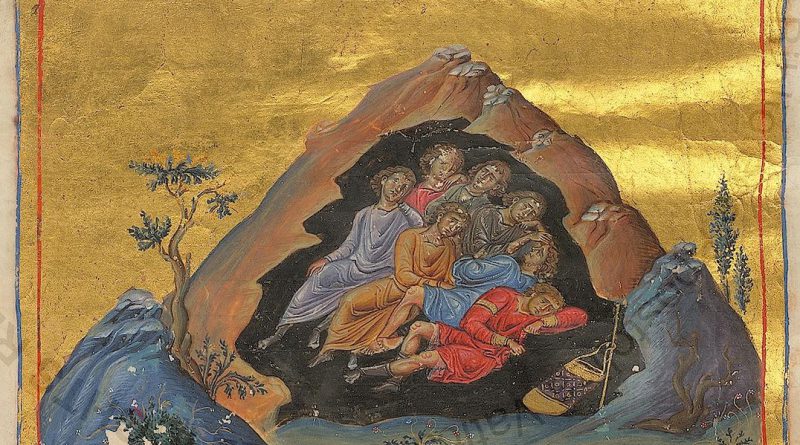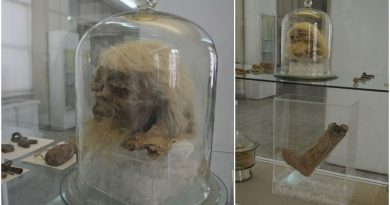Seven Sleepers – Tale of Time Travel
In the Islamic and Christian traditions, the Seven Sleepers, otherwise known as Aṣḥāb al-kahf, Sleepers of Ephesus and Companions of the Cave, is a medieval legend about a group of youths who hid inside a cave outside the city of Ephesus (modern-day Selçuk, Turkey) around AD 250 to escape one of the Roman persecutions of Christians and emerged some 300 years later. Another version of the story appears in the Quran (18:9–26). It was also translated into Persian, Kyrgyz, and Tatar.
Accounts are found in at least nine medieval languages and preserved in over 200 manuscripts, mainly dating to between the 9th and 13th centuries.
Early versions do not all agree on or even specify the number of sleepers. The Jews and the Christians of Najran believed in only three brothers; the East Syriac, five. Most Syriac accounts have eight, including a nameless watcher which God sets over the sleepers. A 6th century latin text titled Pilgrimage of Theodosius featured the sleepers as seven people in number, with a dog named Viricanus. However, in Islam their specific number is not mentioned. Qur’an 18:22 discusses the disputes regarding their numbers. The verse says:
Some will say, “They were three, their dog was the fourth,” while others will say, “They were five, their dog was the sixth,” only guessing blindly. And others will say, “They were seven and their dog was the eighth.” Say, O Prophet, “My Lord knows best their exact number. Only a few people know as well.” So do not argue about them except with sure knowledge, nor consult any of those who debate about them.
The number of years the sleepers slept also varies between accounts. The highest number, given by Gregory of Tours, was 373 years. Some accounts have 372. Jacobus de Voragine calculated it at 196 (from the year 252 until 448). Other calculations suggest 195. Islamic accounts, including the Qur’an, give a sleep of 309 years. These are presumably lunar years, which would make it 300 solar years. Qur’an 18:25 says, “And they remained in their cave for three hundred years and exceeded by nine.”
Account in the Quran
The story of the Companions of the Cave (Arabic: أصحاب الکهف, romanized: ‘aṣḥāb al-kahf) is referred to in Quran 18:9-26. The precise number of the sleepers is not stated. The Quran furthermore points to the fact that people, shortly after the incident emerged, started to make “idle guesses” as to how many people were in the cave. To this the Quran asserts that: “My Sustainer knows best how many they were”. Similarly, regarding the exact period of time the people stayed in the cave, the Quran, after asserting the guesswork of the people that “they remained in the cave for 300 years and nine added”, resolves that “God knows best how long they remained [there].” According to the 25th verse of Al-Kahf, the Companions of the Cave have slept for 300 years in the solar calendar and slept 309 in the lunar calendar since the lunar calendar is 11 days shorter than the solar, which explains the inclusion of the additional nine years. The Quran says the sleepers included a dog, who sat at the entrance of the cave.
Story
The story says that during the persecutions by the Roman emperor Decius, around AD 250, seven young men were accused of following Christianity. They were given some time to recant their faith, but they refused to bow to Roman idols. Instead they chose to give their worldly goods to the poor and retire to a mountain cave to pray, where they fell asleep. The Emperor, seeing that their attitude towards paganism had not improved, ordered the mouth of the cave to be sealed. Headstones in the Siebenschläferkirche (Rotthof), Germany Decius died in 251, and many years passed during which Christianity went from being persecuted to being the state religion of the Roman Empire.
At some later time—usually given as during the reign of Theodosius II (408–450)—in AD 447 when heated discussions were taking place between various schools of Christianity about the resurrection of the body in the day of judgement and life after death, a landowner decided to open up the sealed mouth of the cave, thinking to use it as a cattle pen. He opened it and found the sleepers inside. They awoke, imagining that they had slept but one day, and sent one of their number to Ephesus to buy food, with instructions to be careful. Upon arriving in the city, this person was astounded to find buildings with crosses attached; the townspeople for their part were astounded to find a man trying to spend old coins from the reign of Decius. The bishop was summoned to interview the sleepers; they told him their miracle story, and died praising God. The various lives of the Seven Sleepers in Greek are listed and in other non-Latin languages at BHO.
Caves of the Seven Sleepers
Several sites are attributed as the “Cave of the Seven Sleepers”, but none have been archaeologically proven to be the actual site. As the earliest versions of the legend spread from Ephesus, an early Christian catacomb came to be associated with it, attracting scores of pilgrims. On the slopes of Mount Pion (Mount Coelian) near Ephesus (near modern Selçuk in Turkey), the grotto of the Seven Sleepers with ruins of the religious site built over it was excavated in 1926–1928.[28]: 394 The excavation brought to light several hundred graves dated to the 5th and 6th centuries. Inscriptions dedicated to the Seven Sleepers were found on the walls and in the graves. This grotto is still shown to tourists.
Other possible sites of the cave of the Seven Sleepers are in Damascus, Syria and Afşin and Tarsus, Turkey. Afşin is near the antique Roman city of Arabissus, to which the East Roman Emperor Justinian paid a visit. The site was a Hittite temple, used as a Roman temple and later as a church in Roman and Byzantine times. The Emperor brought marble niches from Western Anatolia as gifts for it, which are preserved inside the Eshab-ı Kehf Kulliye mosque to this day. The Seljuks continued to use the place of worship as a church and a mosque. It was turned into a mosque over time, with the conversion of the local population to Islam.
There is a cave near Amman, Jordan, also known as the cave of seven sleepers, which has eight smaller sealed tombs present inside and a ventilation duct coming out of the cave.
Source: Wikipedia



